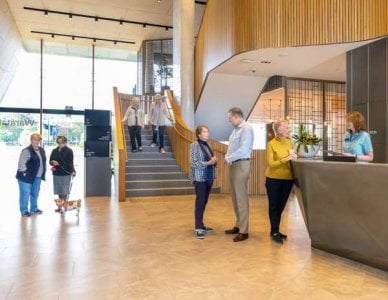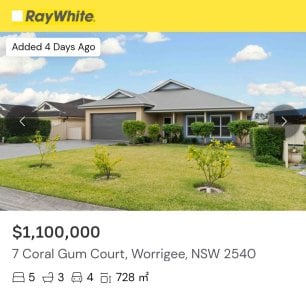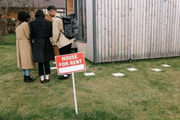These homes are becoming a top choice for seniors! Would you live here?
By
Danielle F.
- Replies 16
For seniors, retirement is often seen as a quiet life in a sprawling, leafy village.
Yet, as times change, many seniors have been updating their visions and plans for their golden years.
Across Australia, a new trend is taking shape, and this approach could be a game-changer for many.
The days of retirees being tucked away in distant suburbs are fading fast.
With property prices soaring and land at a premium, especially in major cities, developers are reimagining what retirement living could look like.
Instead of building out, they're building up.
Developers are planning to create vibrant, multi-storey communities in some of the country's most sought-after locations.
These homes will then be packed with amenities and located close to shops, transport, and medical services.
'Given the nature of the housing supply markets around the country, some of the only ways for these people to keep living in the communities they've loved is to move into more dense residential offerings,' Daniel Gannon, Executive Director of the Retirement Living Council, explained.
So, what can you expect from these new high-rise retirement villages?
These homes promise amenities such as swimming pools, gyms, cafes, libraries, communal gardens, and even cinemas.
Many are located in prime spots close to shopping centres, parks, and public transport.
Retiree Sue Archer passed up the traditional retirement villages in favour of Aveo's Bella Vista Haven.
Aveo's Bella Vista Haven is a modern, vertical community located in New South Wales.
Sue's modern home has fully accessible apartments and 24-hour emergency call systems.
For her, the appeal of a high-rise retirement village was the promise of a lively social environment, a strong sense of community, and top-notch facilities all under one roof.
'I'm currently living in a two-bedroom apartment where all my neighbours are never around because they're all at work,' Sue shared.
'I just found I'm really isolated now.'
It's not just Aveo leading the charge.
Eight out of ten new retirement villages have also embraced the high-rise model.
For many retirees, this means less time spent on home maintenance and more time enjoying life.
The social aspect has been a big drawcard—regular events, clubs, and shared spaces make it easy to meet new friends and stay connected.
However, moving into a retirement village is a big decision that comes with financial responsibilities.
Retirement properties could be up to 43 per cent cheaper than equivalent apartments in the same area.
Yet, there are some key differences between these properties.
Bella Vista Haven operates on a leasehold model.
Instead of buying the apartment outright, residents purchase the right to lease it for up to 99 years with no stamp duty.
However, freehold options for those who want to own the property still attract stamp duty.
There's also a monthly fee to cover the maintenance of services and facilities.
Most contracts include an exit fee and a refurbishment charge when tenants leave.
'We say to any prospective resident thinking about moving into a retirement village to obtain independent legal and financial advice to make sure that this move is right for your conditions,' Mr Gannon advised.
While the idea of high-rise living might not appeal to everyone, these new retirement villages offer an alternative for seniors who want to downsize without compromising their lifestyle or location.
For many, it's a chance to enjoy the best of both worlds: the security and support of a retirement community with all the excitement and convenience of city living.

Are you considering a move to a retirement village? Would you prefer a traditional, ground-level community, or does the idea of high-rise living tempt you? What amenities or features would be most important to you? Please share your thoughts and insights about these homes in the comments section below!
Yet, as times change, many seniors have been updating their visions and plans for their golden years.
Across Australia, a new trend is taking shape, and this approach could be a game-changer for many.
The days of retirees being tucked away in distant suburbs are fading fast.
With property prices soaring and land at a premium, especially in major cities, developers are reimagining what retirement living could look like.
Instead of building out, they're building up.
Developers are planning to create vibrant, multi-storey communities in some of the country's most sought-after locations.
These homes will then be packed with amenities and located close to shops, transport, and medical services.
'Given the nature of the housing supply markets around the country, some of the only ways for these people to keep living in the communities they've loved is to move into more dense residential offerings,' Daniel Gannon, Executive Director of the Retirement Living Council, explained.
So, what can you expect from these new high-rise retirement villages?
These homes promise amenities such as swimming pools, gyms, cafes, libraries, communal gardens, and even cinemas.
Many are located in prime spots close to shopping centres, parks, and public transport.
Retiree Sue Archer passed up the traditional retirement villages in favour of Aveo's Bella Vista Haven.
Aveo's Bella Vista Haven is a modern, vertical community located in New South Wales.
Sue's modern home has fully accessible apartments and 24-hour emergency call systems.
For her, the appeal of a high-rise retirement village was the promise of a lively social environment, a strong sense of community, and top-notch facilities all under one roof.
'I'm currently living in a two-bedroom apartment where all my neighbours are never around because they're all at work,' Sue shared.
'I just found I'm really isolated now.'
It's not just Aveo leading the charge.
Eight out of ten new retirement villages have also embraced the high-rise model.
For many retirees, this means less time spent on home maintenance and more time enjoying life.
The social aspect has been a big drawcard—regular events, clubs, and shared spaces make it easy to meet new friends and stay connected.
However, moving into a retirement village is a big decision that comes with financial responsibilities.
Retirement properties could be up to 43 per cent cheaper than equivalent apartments in the same area.
Yet, there are some key differences between these properties.
Bella Vista Haven operates on a leasehold model.
Instead of buying the apartment outright, residents purchase the right to lease it for up to 99 years with no stamp duty.
However, freehold options for those who want to own the property still attract stamp duty.
There's also a monthly fee to cover the maintenance of services and facilities.
Most contracts include an exit fee and a refurbishment charge when tenants leave.
'We say to any prospective resident thinking about moving into a retirement village to obtain independent legal and financial advice to make sure that this move is right for your conditions,' Mr Gannon advised.
While the idea of high-rise living might not appeal to everyone, these new retirement villages offer an alternative for seniors who want to downsize without compromising their lifestyle or location.
For many, it's a chance to enjoy the best of both worlds: the security and support of a retirement community with all the excitement and convenience of city living.
Key Takeaways
- Retirement villages in Sydney are shifting away from traditional ground-level layouts towards high-rise buildings.
- Vertical retirement villages are becoming popular, with eight out of ten new developments now consisting of high-rise apartments.
- Leasehold models allow residents to lease their apartments for up to 99 years with no stamp duty, yet tenants have to pay monthly service fees and exit and refurbishment charges.
- Prospective residents were encouraged to seek independent legal and financial advice, as contracts and fees could vary significantly between different retirement villages.









